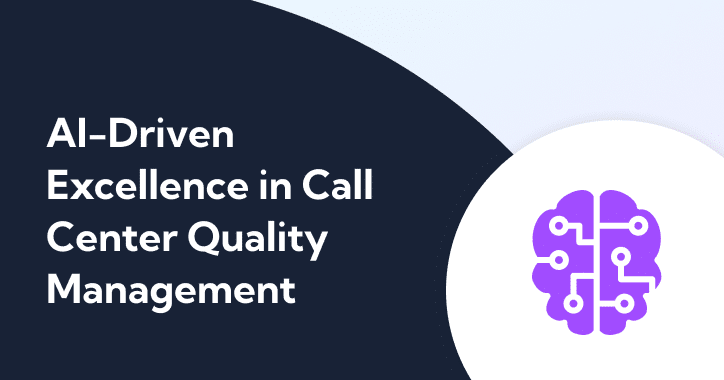Let’s be real. The telecommunication industry has a long-standing reputation for providing notoriously poor customer experiences. In fact, telecom boasts the lowest industry average among both B2B and B2C audiences, with a Net Promoter Score® average of just 31. Even logistics, an industry widely regarded for terrible customer experiences, was able to finesse an NPS average of at least 38.
When the customer experience is as integral to the long-term financial success of an enterprise as it is with contact centers, there’s no excuse for an NPS average this low. Modern contact centers demand an integrated, real-time, and satisfying experience that can combat this notoriously poor performance.
Why is the Current Customer Experience So Poor?
The purpose of a contact center is to quickly and efficiently resolve customer concerns, whether that’s processing an insurance claim or scheduling a service appointment. Yet, a slew of unexpected factors often makes the “quickly” part of the job description nearly impossible. This could explain why the average American spends an incredible 45 days of their life on hold with a contact center.
So, what’s responsible for slowing down a contact center? Across the board, all signs point to outdated script dialogue and a lengthy resolution process. More often than not, agents find themselves parroting information from an internal document that’s even older than they are to remain in compliance — which rarely leads to call resolution in a simple manner, if in any manner at all.
Many customers ultimately demand an escalation, to the point that we’ve seen the number of calls sent up through the chain of command increase by more than 68% during the COVID-19 pandemic alone. The calls rated as “difficult” by agents have also grown by 100% during this time, indicating that the contact center space can use some help.
How Can We Redefine Contact Center Expectations?
Less than one-third of customer service professionals claim their organization excels at response times, and even fewer feel proficient in handle times and first-contact resolution. Let’s change that. Here are four ways contact centers can redefine their reputation for good.
1. Guide Customer Calls with Conversational Intelligence
Artificial intelligence (AI) and data-driven analytics can revolutionize the customer experience in contact centers for agents and callers alike. Rather than rely on rigid scripts, conversational intelligence software automatically enables agents with real-time guidance (RTG) to accurately respond to customer queries, not just provide the next-best answer.
Conversational intelligence also provides dialogue prompts that help ride the line between compliance and empathy. Machine learning identifies the most effective way to answer a question or move a conversation forward based on historical data, so agents can focus less on problem-solving and more on forming relationships and bettering the customer experience.
2. Identify and Improve the Source of Low Scores
You can’t solve the problems you don’t know you have. Detailed quality assurance (QA) scores can reveal the specific criteria teams or individual agents are struggling with; however, floor managers often only have time to QA less than 1% of calls. That’s not a very good sample size, and makes it easy to miss slip ups or compliance mistakes.
It’s important to drill down into each real-time customer interaction to unearth what’s driving poor experiences, so you nix problems before they happen. Real-time QA platforms let you do this instantly on 100% of calls, from top teams to freshly onboarded agents, to identify and improve problematic criteria.
3. Work on Coaching for Continuous Improvement
At the start of the pandemic, more than 40% of customers reported feeling frustrated during COVID-related calls and upwards of 20% of all contact center calls were scored as “difficult.” The implementation of targeted coaching for consumer advocacy and similar techniques saw both consumer frustration and difficulty rating drop to 7% in just two weeks.
Though reversing the industry-worst NPS average isn’t something that can be done overnight, it doesn’t have to — it just needs to continuously improve. Real-time coaching for teams and agents can help guide advocacy techniques and compliance concerns throughout ongoing service calls to help contact centers gradually improve low QA scores and even lower NPS averages.
4. Cater to a Diverse Customer Base with Multiple Languages
Unfortunately, linguistic barriers and other difficulties in communication have quickly soured customer experiences over the phone. A recent study of 1 million customer service calls found that instances of both agents and customers saying, “I can’t understand you,” have skyrocketed hold times by upwards of 30% and doubled the rate of escalations in a contact center. In today’s global market, contact centers must deliver world-class experiences across multiple cultures.
It’s (Beyond) Time to Redefine the Contact Center Reputation
Contact centers have become synonymous with poor customer experiences, which isn’t fair for anyone — not the callers nor the dedicated agents who do their best to effectively resolve each call. It’s time to redefine the contact center reputation once and for all with software designed to drive better conversations, form stronger relationships, and boost customer satisfaction.
Balto is a real-time guidance platform for contact centers that’s built to not only prevent mistakes before they happen but also deliver excellent conversations that deviate from an outdated script. With real-time conversational intelligence, QA, coaching, and an expanding AI-language base, contact centers can improve their customer experience and advance their business with Balto.
Ready to redefine your reputation? Book a demo today.






